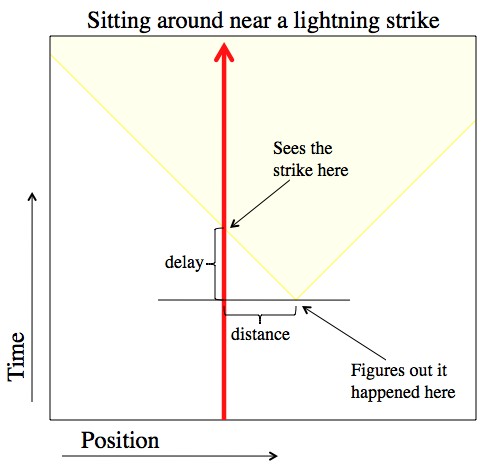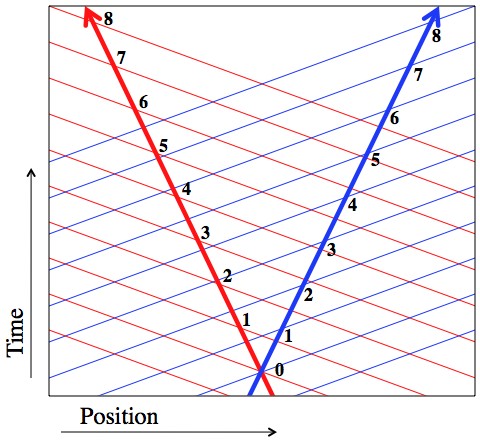Physicist: They definitely both experience time dilation. That is to say, they both see the other person moving through time slower (you will always see your own clock running normally, in all circumstances). The short resolution to the “paradox” is: if you’re flying past each other, and never come back to the same place again to compare clocks, what’s the problem? You may both observe the other person’s clock running slower, but that’s not a contradiction in any “physical sense”. Of course if you do meet up again, then you’ve got the “twin paradox”, which still isn’t a problem (or a paradox). One of the most frustrating things about the universe is that there is no such thing as “absolute time“, which would allow you to say “who’s right”. If you could ask the universe “what time is it?” the universe’s best answer would be “that depends on who’s asking”. The universe is kind of a smart ass. There’s a halfway decent explanation the twin paradox here: “Q: How does the twin paradox work?” and there’s a quarterway decent, possibly simpler, explanation of why movement makes time pass slower here: “Q: Why does going fast or being lower make time slow down?“. Personally, I think the question of this post is far more profound. I should note here that the language physicists use makes the situation sound subjective; “the observer sees…”, “the person experiences…”, etc. However, none of the effects (covered in a minute) are due to observer based effects, like the delay caused by the time it takes light to get from place to place. Everything here is literal and physically real. You don't see an event when it happens, you see it when the light from the event gets to you. But you can easily figure out when it did happen by dividing the distance to the event by C, giving you the time delay. This diagram is pretty standard physicist fare. If you want to draw a picture of something happening in 4 dimensional spacetime, you just drop two of the spacial dimensions. So here, time is up, space is left/right, the red arrow is a person (it doesn’t have to be a person) sitting still and moving forward in time (like you’re doing right now, in all likelihood). The yellow triangle is a lightning strike (at the bottom) and the light expanding out from it. The picture should make sense; the longer after the lightning strike (the higher on the picture) the farther the light from the strike has traveled (wider to the left and right). “Lightning” is a common example of an event, because it hits in a definite place at a very definite time. Plus, (spoiler alert) lightning is bright so, unlike most small instantaneous things, it makes sense that everyone should be able to see them. Now let’s say you’ve got two people; Alice, who likes to hang out by the train tracks, andBob, who likes to ride trains on said tracks. A train car (light blue) moves to the right. Right when Alice and Bob are eye-to-eye the front and back of the train car are hit by lightning. This moment, that Alice calls "Now!", is the red line. As the train, with Bob sitting in the exact center, passes Alice they high-five each other. Suddenly, both ends of the train are struck by lightning. Alice knows this because, verysoon after the lightning strikes, the light from them get to her. Being smart, she realizes that the strikes must have happened at the same time, because they happened equally far away from her, and the light took the same amount of time to get to her (see picture). Moreover, really milking her cleverness, she predicts that Bob will see the lightning bolt at the front of the train first, and the lightning bolt at the back of the train second (see picture, some more). The speed of light, C, is an absolute. No matter where you are, or how fast you’re moving, C stays exactly the same. So Alice’s reasoning is completely solid, and she’s right when she says that the lightning bolts happened at the same time. When you say that two things are “happening at the same moment”, or “happening now” you’re saying that they’re on the same spacetime plane, that I’ll call a “moment plane”. In the same way that a regular 2D plane is a big, flat subset of regular 3D space, the moment planes are big flat 3D subsets of 4D spacetime. So the high five, the lightning strikes, and everything else in the universe at that moment, are all in the same “moment plane”. However, that doesn’t necessarily mean that everything in that plane happens at the same time (although they do for someone, in this case Alice). Same situation from the perspective of the train. Bob sees the lightning at the front of the train first, and the lightning at the back of the train second, and can even figure out that Alice will see them at the same time. However, he disagrees with Alice about when things happen. Around 1900 the Michelson Morley experiment (among others) was demonstrating that the speed of light seemed to be the same to everyone, regardless of whether or not they’re moving. Einstein’s great insight was “Hey everybody, if the speed of light seemsto be the same regardless of the observers movement, then maybe it really is?” He was a staggering genius. Also, he was exactly right. So, Alice was right about Bob seeing the front bolt first, and the back bolt second. However, as far as Bob’s concerned, she was wrong about why. Using the same reasoning Alice did, he figures that the speed of light is fixed (whether or not you’re moving), and the distance from him to the front and back of the train is the same, so since he saw the front bolt before the back, it must have happened first. And he’s right. Moreover, he thinks that the reason that Alice saw both at the same time is that she’s moving to the left, away from the first bolt and toward the second (picture). The first thing that most people say when the hear about the train thought experiment is “Isn’t the person on the tracks correct, since they really are sitting still?” Nope! The tracks may be bigger, but (as Dr. V. E. Kilmer discovered experimentally) there’s no physical way to say who’s moving and who’s not. Both Alice and Bob are completely correct. What’s very strange is that the ideas we intuitively have about “nowness” are wrong. As soon as two people are moving with respect to each other, the set of points that they consider “now” are no longer the same (different moment planes). Alice’s “now” is the same red line above, but Bob’s sees it as “tilted”. After all of that, what you should take away is: “a things’s moment planes tilts up in the direction of its movement” (picture above). If this is the first time you’ve seen this sort of stuff, you shouldn’t really believe any of it. Or at least, you shouldn’t have internalized it. This stuff isn’t terribly complicated, but it is really mind-bending, so take a moment. Physically tilted "nows" are difficult to wrap your mind around. To encourage the reader to pause or go back a little bit; consider the above. Finally, to actually answer the question, imagine the situation from the point of view of someone in between Alice and Bob, who sees them flying off at equal speeds in opposite directions. This puts Alice and Bob on equal footing, and there’s no questions about “who’s right” or “who’s moving”. Alice and Bob's now planes at various times. If you were to ask Alice "how much time has passed for Bob now?" the answer will always be "less time than for Alice." The situation with Bob is exactly symmetrical. Since the moment planes of each person “tilts up in the direction of movement”, each person is always trailing behind the other in time. When they pass each other they each start their stopwatches. For that one moment they can agree that T=0 for both of them. But that’s where the agreement ends. If you ask Bob about what set of points in the universe (both position and time) correspond to T=7, he’ll have no trouble telling you. Specifically, he’ll tell you “right now my stopwatch reads ‘T=7′ and, F.Y.I., Alice’s stopwatch reads ‘T=5′”. Bob recognizes that this is because her clock is running slower, and he’s right. At least, he’s right in terms of how time is flowing for him. If you were to run over to Alice at the moment that her stop watch reads 5 (using aTARDIS or something), she would say “right now my stopwatch reads ‘T=5′ and Bob’s reads ‘T=3.5′”. Also being clever, she realizes that this is because Bob’s clock is running slower, and she’s right. Notice she doesn’t say “T=7″. Once again, this is because they disagree on what “now” means, since their moment planes aren’t the same. The first question that should be coming to mind is something like “Well, what’s reallyhappening?” or “How is time actually passing?”. Sadly, time is a strictly local phenomena. How it flows is determined (defined really) by relative position and relative velocity. That is to say, there is no “universal clock” that describes how time passes overall. The only reason that there seems to be some kind of universal clock is that we (people) are all moving at very nearly the same speed. Or equivalently, we’re all sitting still in very much the same way. Our time, length, and speed scale are all just too small.




Tuesday, July 5, 2011
Q: According to relativity, two moving observers always see the other moving through time slower. Isn’t that a contradiction? Doesn’t one have to be faster?
Subscribe to:
Post Comments (Atom)
No comments:
Post a Comment